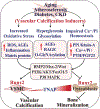Arterial Stiffness: A Focus on Vascular Calcification and Its Link to Bone Mineralization
- PMID: 32237904
- PMCID: PMC7199843
- DOI: 10.1161/ATVBAHA.120.313131
Arterial Stiffness: A Focus on Vascular Calcification and Its Link to Bone Mineralization
Abstract
This review focuses on the association between vascular calcification and arterial stiffness, highlighting the important genetic factors, systemic and local microenvironmental signals, and underlying signaling pathways and molecular regulators of vascular calcification. Elevated oxidative stress appears to be a common procalcification factor that induces osteogenic differentiation and calcification of vascular cells in a variety of disease conditions such as atherosclerosis, diabetes mellitus, and chronic kidney disease. Thus, the role of oxidative stress and oxidative stress-regulated signals in vascular smooth muscle cells and their contributions to vascular calcification are highlighted. In relation to diabetes mellitus, the regulation of both hyperglycemia and increased protein glycosylation, by AGEs (advanced glycation end products) and O-linked β-N-acetylglucosamine modification, and its role in enhancing intracellular pathophysiological signaling that promotes osteogenic differentiation and calcification of vascular smooth muscle cells are discussed. In the context of chronic kidney disease, this review details the role of calcium and phosphate homeostasis, parathyroid hormone, and specific calcification inhibitors in regulating vascular calcification. In addition, the impact of the systemic and microenvironmental factors on respective intrinsic signaling pathways that promote osteogenic differentiation and calcification of vascular smooth muscle cells and osteoblasts are compared and contrasted, aiming to dissect the commonalities and distinctions that underlie the paradoxical vascular-bone mineralization disorders in aging and diseases.
Keywords: arterial stiffness; atherosclerosis; diabetes mellitus; renal insufficiency, chronic; vascular calcification.
Conflict of interest statement
DISCLOSURES
The authors have no potential conflicts of interests to disclose.
Figures



References
-
- Benetos A, Waeber B, Izzo J, Mitchell G, Resnick L, Asmar R, Safar M. Influence of age, risk factors, and cardiovascular and renal disease on arterial stiffness: Clinical applications. American journal of hypertension. 2002;15:1101–1108 - PubMed
-
- van Popele NM, Grobbee DE, Bots ML, Asmar R, Topouchian J, Reneman RS, Hoeks AP, van der Kuip DA, Hofman A, Witteman JC. Association between arterial stiffness and atherosclerosis: The rotterdam study. Stroke. 2001;32:454–460 - PubMed
-
- Lakatta EG. Arterial and cardiac aging: Major shareholders in cardiovascular disease enterprises. 2003;107:490–497 - PubMed
-
- O’Rourke MF, Safar ME. Relationship between aortic stiffening and microvascular disease in brain and kidney: Cause and logic of therapy. Hypertension. 2005;46:200–204 - PubMed
Publication types
MeSH terms
Grants and funding
LinkOut - more resources
Full Text Sources

